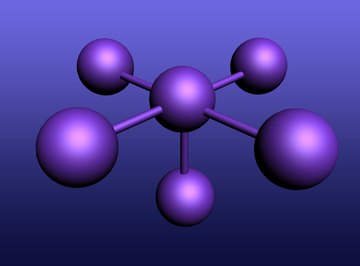
Since John Dalton established the existence of atoms in the early 1800s, they have been considered the building blocks of matter. Scientists now know that atoms themselves are built from smaller particles, which are in turn composed of even smaller ones, and nobody really knows how far the regression goes.
On the constructive side, however, atoms combine to form all the chemical compounds that comprise the physical world and everything in it.
What Is a Group of Atoms Called?
Fill in the blank: "A __ is composed of two or more atoms held together by chemical bonds." There is more than one answer, but the one that probably crossed your mind first is "molecule." Every grouping of two or more atoms is a molecule. Some are very simple, such as the oxygen molecules you breathe, which are formed by two oxygen atoms (O2), and some are huge, like the TTN genes in the human body. Composed of carbon, hydrogen, oxygen, nitrogen and sulfur, the so-called Titan molecule is composed of a whopping 539,030 atoms.
The other word you can use to fill in the blank is "compound." A compound is a molecule that is a substance made of two or more elements chemically combined in a set ratio. It contains more than one element, or type of atom. A compound is always a molecule, but a molecule isn't always a compound. The Titan molecule is a compound, and simpler examples of compounds include include sodium chloride (NaCl), or table salt, and dihydrogen oxide (H2O), or water.
How Do Atoms Combine to Form a Molecule?
To understand how atoms combine, remember that they are composed of smaller particles. They are called electrons, protons and neutrons. Electrons have a negative charge, protons have an equal positive charge, and neutrons have no charge. An atom has an equal number of electrons and protons, which makes it electrostatically neutral, but if electrostatic neutrality was all that mattered, atoms would never combine.
Electrons circle the nucleus in discrete orbits, or shells, that can hold a fixed number of them, and that number increases with the radius of the orbit.
If an atom is missing electrons to fill a shell, usually its outer one, it is unbalanced, and to gain stability, it seeks to get them from another atom in one of two ways. It can "steal' an electron (more generously, the other atom can "donate" it), or the two atoms can share electrons. Either way, the atoms become bonded chemically to form a molecule.
When an atom donates an electron to the other, both atoms become ions, each with an opposite charge, and they are bonded by electrostatic attraction. This is called an ionic bond. When atoms share electrons to complete each other's outer shells, they form a covalent bond, which isn't as strong as an ionic bond, but it's much more common.
Types of Molecules
If you don't like to call molecules compounds, you can distinguish them as homonuclear, which means made of one element, or heteronuclear, which means made of more than one element. H2, O2 and P4 are examples of the former, while CO2, HCl and CH4 are examples of the latter. The list of heteronuclear molecules is obviously much longer than that of homonuclear ones, as most molecules are compounds.
Molecules aren't always electrostatically neutral. Ionic molecules combine in a way that leaves them with a charge, and they can form ionic bonds with other molecules. Some molecules, such as the water molecule, are polar, because the way the atoms combine creates a net positive charge on one side and a negative charge on the other. This charge isn't as strong as the one that forms a chemical bond, but it's strong enough to produce some strange and important behavior.
References
About the Author
Chris Deziel holds a Bachelor's degree in physics and a Master's degree in Humanities, He has taught science, math and English at the university level, both in his native Canada and in Japan. He began writing online in 2010, offering information in scientific, cultural and practical topics. His writing covers science, math and home improvement and design, as well as religion and the oriental healing arts.
Photo Credits
Photos.com/Photos.com/Getty Images
